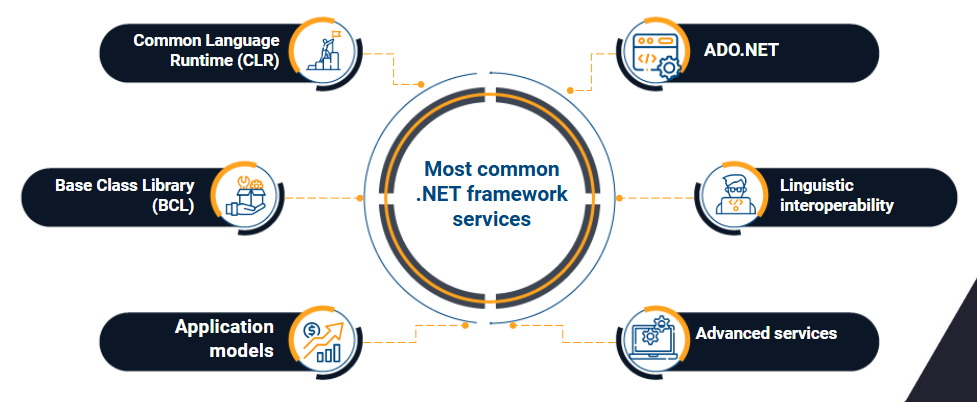
What services does the .NET Framework provide?
May 24, 2024
Table of contents
Quick Access

For the creation of sites or web applications, there are different frameworks and programming languages with multiple functions on the market, among them the .NET framework stands out and in this article, we are going to explain its different services.
“.NET Framework is used to create and run software applications. .NET applications can run on many operating systems, using different .NET implementations. .NET Framework is used to run .NET applications on Windows” they explain in their official documentation.
There they briefly talk about the different uses of this technology, summarizing “Software developers use the .NET Framework to create many different types of applications: websites, services, desktop applications, and more with Visual Studio. Visual Studio is an integrated development environment (IDE) that provides development productivity tools and debugging capabilities. Check out the .NET Customer Presentation to see examples of what people are building with .NET.”

Most common .NET framework services
The .NET Framework, developed by Microsoft, is a comprehensive and consistent programming model designed to create applications that deliver visually stunning user experiences and fluid, secure communication. Provides a wide range of services to support application development and execution. Next, we explore the core services provided by the .NET Framework.
1. Common Language Runtime (CLR)
Common Language Runtime (CLR) is the heart of the .NET Framework. Provides a managed runtime environment for .NET programs. Key services offered by CLR include:
- Memory Management: Automatic memory management using garbage collection helps developers manage memory allocation and freeing, reducing memory leaks and optimizing performance.
- Security: CLR enforces code access security, ensuring that applications run with appropriate permissions and protecting against unauthorized operations.
- Exception Handling: CLR provides a structured way to handle errors through exceptions, ensuring robust and error-resistant applications.
- Just-in-time (JIT) compilation: Converts intermediate language (IL) code into native machine code just before execution, optimizing performance.
2. Base Class Library (BCL)
The Base Class Library (BCL) is a rich collection of reusable classes, interfaces, and value types that provide essential functionality such as:
- Data Types and Collections: Fundamental data types (such as integers, and strings) and collection classes (such as lists, and dictionaries) for managing data efficiently.
- File Operations and I/O: Classes for manipulating, reading, and writing files in streams.
- Networking: Support for network communication, including HTTP requests, sockets, and web services.
- XML Processing: tools to analyze, query, and transform XML documents.
3. Application models
The .NET Framework supports several application models, allowing developers to create different types of applications:
- Windows Forms: for developing rich desktop client applications with graphical user interfaces.
- ASP.NET: To create dynamic web applications and services. ASP.NET provides features for web development, such as server controls, state management, and authentication.
- WPF (Windows Presentation Foundation): A framework for creating visually appealing desktop applications with advanced graphics, animations, and multimedia support.
- WCF (Windows Communication Foundation): For creating service-oriented applications that can communicate across multiple platforms and protocols.
- WF (Windows Workflow Foundation): Provides tools for creating workflows, which are sequences of operations that automate business processes.

4.ADO.NET
ADO.NET is a set of components in the .NET Framework that make data access easier. It allows applications to connect to data sources such as databases and XML files, execute commands, and manage disconnected data. Key features include:
- Connection Management: Establish and manage connections to various data sources.
- Data adapters: Retrieve and save data between a database and a data set.
- Dataset: An in-memory representation of data that can be manipulated programmatically and used to bind to user interface elements.
5. Linguistic interoperability
One of the important advantages of the .NET Framework is its support for language interoperability. This means that code written in different programming languages (such as C#, VB.NET, F#) can interact seamlessly. This is achieved through:
- Common Type System (CTS): Standardizes data types across different languages.
- Common Language Specification (CLS): Defines a subset of CTS that all .NET languages are expected to support, ensuring interoperability.
6. Advanced services
The .NET Framework also includes several advanced services and tools that enhance the development experience:
- LINQ (Language Integrated Query): Allows you to query collections, databases, XML, and other data sources using consistent syntax built into .NET languages.
- Entity Framework: An object-relational mapping (ORM) framework that simplifies database interactions by allowing developers to work with data as objects.
- Parallel programming: Provides libraries and tools for concurrent and parallel programming, improving performance on multicore processors.
The .NET Framework is a powerful and versatile platform that provides a wide range of services to support application development. From core CLR and BCL services to advanced capabilities for data access, user interface design, and web development, .NET provides the tools and libraries needed to build robust, secure, and high-performance applications.
Whether you develop desktop applications, web services, or enterprise-level solutions, the .NET Framework is equipped to meet the diverse needs of modern software development.
We recommend you on video
Related Blogs
-5.45.09-p.m.png)
Artificial Intelligence Development Services for the Banking Industry
-12.37.04-p.m.png)
AI and IT Staff Augmentation Teams to Improve Productivity
-2.11.52-p.m.png)
React in Development: Why CEOs Should Pay Attention

Industry-Focused Web Development Service: Is It What Your Business Needs?

What does an ETL developer do?
-100.jpg)